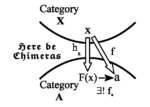Category theory has foundational importance because it provides conceptual lenses to characterize what is important and universal in mathematics—with adjunction seeming to be the primary lens. Our topic is a theory showing “where adjoints come from”.
Double-Entry Bookkeeping: Mathematical Formulation and Generalization
This is Chapter 6 from my book: Ellerman, David. 1995. Intellectual Trespassing as a Way of Life: Essays in Philosophy, Economics, and Mathematics. Lanham MD: Rowman & Littlefield.
The essay on double-entry bookkeeping (DEB) is intellectually interesting for several reasons in spite of the well-known soporific aspects of bookkeeping. Several of the essays in the volume explicitly employ the analogy between additive and multiplicative operations (i.e., the common group-theoretic properties of additive groups of numbers and multiplicative groups of nonzero numbers). For instance, given the system of multiplying whole numbers or integers, there is no operation inverse to multiplication (i.e., there is no division). But there is a standard method of enlarging the system to allow division. Consider pairs of whole numbers a/b (with b ¹ 0) and define multiplication in the obvious way: (a/b)(c/d) = (ac)/(bd). These ordered pairs of integers are the “fractions” and they allow the operation of division (“multiply by the reciprocal”).
Now substitute addition for multiplication. We start with the additive system of positive numbers along with zero (i.e., the non-negative numbers) where is no inverse operation to addition (i.e., there is no subtraction). To enlarge the domain of non-negative numbers to include subtraction, consider ordered pairs [a // b] and define addition in the analogous way: [a // b] + [c // d] = [a+c // b+d]. This enlarged system of additive operations on ordered pairs of non-negative numbers allows subtraction (“add on the reversed pair”). The origin of the intellectual trespassing into DEB was the observation that these ordered pair were simply the T-accounts of DEB.
Aside from illustrating the interplay of additive-multiplicative themes, the essay illustrates one of the most astonishing examples of intellectual insulation between disciplines, in this case, between accounting and mathematics. Double-entry bookkeeping was developed during the fifteenth century and was first recorded as a system by the Italian mathematician Luca Pacioli in 1494. Double-entry bookkeeping has been used as the accounting system in market-based enterprises of any size throughout the world for several centuries. Incredibly, however, the mathematical basis for DEB is not known, at least not in the field of accounting.
Double-entry Bookkeeping: The Mathematical Treatment
This publication represents success in a long struggle, stretching over three decades, to get the mathematical treatment of double-entry bookkeeping published in an accounting journal.
Mathematics of Double Entry Bookkeeping
This is a scan of the first publication in a mathematics journal of the mathematical treatment of double-entry bookkeeping using the group of differences construction.
Double Entry Multidimensional Accounting
This is a scan of the first journal publication of the mathematical formulation and generalization to vectors of double-entry bookkeeping.
Economics, Accounting, and Property Theory
This is my first book. In order to develop a mathematical model of the stocks and flows of property inside a firm, I first had to give a math model of the usual double-entry accounting for the stocks and flows of the scalar value, and then generalize it to vectors of property rights.
The Math of Double-Entry Bookkeeping: Part I (scalars)
Double-entry bookkeeping illustrates one of the most astonishing examples of intellectual insulation between disciplines—the very opposite of intellectual trespassing.
The Math of Double-Entry Bookkeeping: Part II (vectors)
Although double-entry bookkeeping (DEB) has been used in the business world for 5 centuries, the mathematical formulation of the double entry method is almost completely unknown. The correct mathematical formulation allows the generalization from the value scalars of ordinary DEB to multi-dimensional accounting using vectors–which is the topic of this post.





